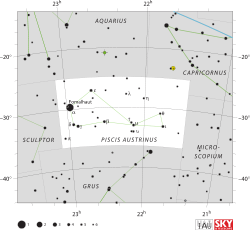Beta Piscis Austrini
 | |
| Observation data Epoch J2000.0 Equinox J2000.0 (ICRS) | |
|---|---|
| Constellation | Piscis Austrinus |
| Right ascension | 22h 31m 30.33038s[1] |
| Declination | −32° 20′ 45.8653″[1] |
| Apparent magnitude (V) | +4.29[2] (4.29 + 6.22)[3] |
| Characteristics | |
| Spectral type | A1 V[4] + A2 V[5][6] |
| U−B color index | +0.02[2] |
| B−V color index | +0.01[2] |
| Astrometry | |
| Radial velocity (Rv) | 5.5±0.5[7] km/s |
| Proper motion (μ) | RA: +59.12[1] mas/yr Dec.: −18.83[1] mas/yr |
| Parallax (π) | 22.84 ± 0.21[1] mas |
| Distance | 143 ± 1 ly (43.8 ± 0.4 pc) |
| Absolute magnitude (MV) | 1.00[8] |
| Details | |
| Mass | 2.33±0.07[8] M☉ |
| Radius | 2.10[9] R☉ |
| Luminosity | 37[8] L☉ |
| Surface gravity (log g) | 4.12±0.03[8] cgs |
| Temperature | 9,638[9] K |
| Rotational velocity (v sin i) | 30[4] km/s |
| Age | 339[8] Myr |
| Other designations | |
| Database references | |
| SIMBAD | data |
Beta Piscis Austrini (β Piscis Austrini) is catalogued as a binary star[5][6] system in the southern constellation of Piscis Austrinus. It is visible to the naked eye with an apparent visual magnitude of +4.29.[2] Based upon an annual parallax shift of 22.84 mas as seen from the Earth,[1] the star is located 143 light years from the Sun. These coordinates are a source of X-ray emission with a luminosity of 88.5×1020 W, which is most likely coming from a source other than the A-type stars.[11]
Oblak (1978) identified this as a triple star system,[3] although subsequent sources list it as a binary.[5][6] The magnitude 4.29[3] primary, component A, is a white-hued A-type main sequence star with a stellar classification of A1 V.[4] It has an estimated 2.3[8] times the mass of the Sun and 2.1[9] times the Sun's radius. The star is radiating 37[8] times the solar luminosity from its photosphere at an effective temperature of 9,638 K.[9] There is evidence for an infrared excess, indicating the presence of an orbiting debris disk. This has an estimated temperature of 188 K, indicating an orbital distance of 12 AU from the host star.[9] The magnitude 7.8 secondary, component B, has a class of A2 V and lies at an angular separation of 30.3 arc seconds.[5][6]
Beta Piscis Austrini is moving through the Galaxy at a speed of 14.4 km/s relative to the Sun. Its projected Galactic orbit carries it between 23,900 and 28,300 light years from the center of the Galaxy.[12]
With Delta and Zeta it constituted Tien Kang ("heavenly rope") in China.[13][14]
References
- 1 2 3 4 5 6 van Leeuwen, F. (2007), "Validation of the new Hipparcos reduction", Astronomy and Astrophysics, 474 (2): 653–664, arXiv:0708.1752, Bibcode:2007A&A...474..653V, doi:10.1051/0004-6361:20078357.
- 1 2 3 4 Nicolet, B. (1978), "Photoelectric photometric Catalogue of homogeneous measurements in the UBV System", Astronomy and Astrophysics Supplement Series, 34: 1–49, Bibcode:1978A&AS...34....1N.
- 1 2 3 Oblak, E. (December 1978), "uvbybeta photometry of wide visual double stars with B, A and F spectral type - I.", Astronomy and Astrophysics Supplement Series, 34: 453–475, Bibcode:1978A&AS...34..453O.
- 1 2 3 Royer, F.; et al. (February 2007), "Rotational velocities of A-type stars. III. Velocity distributions", Astronomy and Astrophysics, 463 (2): 671–682, arXiv:astro-ph/0610785, Bibcode:2007A&A...463..671R, doi:10.1051/0004-6361:20065224.
- 1 2 3 4 Eggleton, P. P.; Tokovinin, A. A. (September 2008), "A catalogue of multiplicity among bright stellar systems", Monthly Notices of the Royal Astronomical Society, 389 (2): 869–879, arXiv:0806.2878, Bibcode:2008MNRAS.389..869E, doi:10.1111/j.1365-2966.2008.13596.x.
- 1 2 3 4 Rodriguez, David R.; et al. (May 2015), "Stellar multiplicity and debris discs: an unbiased sample", Monthly Notices of the Royal Astronomical Society, 449 (3): 3160–3170, arXiv:1503.01320, Bibcode:2015MNRAS.449.3160R, doi:10.1093/mnras/stv483.
- ↑ Gontcharov, G. A. (November 2006), "Pulkovo Compilation of Radial Velocities for 35495 Hipparcos stars in a common system", Astronomy Letters, 32 (11): 759–771, arXiv:1606.08053, Bibcode:2006AstL...32..759G, doi:10.1134/S1063773706110065.
- 1 2 3 4 5 6 7 Gerbaldi, M.; et al. (June 1999), "Search for reference A0 dwarf stars: Masses and luminosities revisited with HIPPARCOS parallaxes", Astronomy and Astrophysics Supplement, 137 (2): 273–292, Bibcode:1999A&AS..137..273G, doi:10.1051/aas:1999248.
- 1 2 3 4 5 Patel, Rahul I.; et al. (May 2014), "A Sensitive Identification of Warm Debris Disks in the Solar Neighborhood through Precise Calibration of Saturated WISE Photometry", The Astrophysical Journal Supplement Series, 212 (1): 23, arXiv:1403.3435, Bibcode:2014ApJS..212...10P, doi:10.1088/0067-0049/212/1/10, 10.
- ↑ "bet PsA -- High proper-motion Star", SIMBAD Astronomical Database, Centre de Données astronomiques de Strasbourg, retrieved 2017-05-27.
- ↑ Schröder, C.; Schmitt, J. H. M. M. (November 2007), "X-ray emission from A-type stars", Astronomy and Astrophysics, 475 (2): 677–684, Bibcode:2007A&A...475..677S, doi:10.1051/0004-6361:20077429.
- ↑ Beta Piscis Austrini (HIP 111188)
- ↑ Allen, Richard Hinckley (1963), Star Names — Their Lore and Meaning: Piscis Australis, the Southern Fish, retrieved 2017-05-27.
- ↑ Tien Kang was possibly derived from 天綱 (Tiān Gāng) meaning Materials for Making Tents. AEEA opinion is, δ Piscis Austrini marking itself and stand alone in this asterism. See (in Chinese) AEEA (Activities of Exhibition and Education in Astronomy) 天文教育資訊網 2006 年 7 月 6 日.
External links
- Kaler, James B. (November 12, 2009), "Beta Piscis Austrini", Stars, University of Illinois.